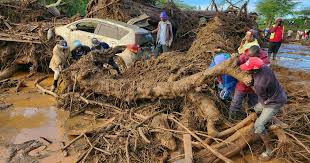
At least 42 people lost their lives as a dam burst near Mai Mahiu in Nakuru county, Kenya’s Rift Valley region. The tragic incident occurred amidst heavy rains and floods that have been affecting the country. Nakuru governor Susan Kihika confirmed the death toll, stating that it might rise as rescuers continue their efforts to recover more bodies from the mud and debris.
The dam’s collapse, which happened recently, adds to the already devastating impact of the ongoing March-May wet season, with the death toll across East Africa reaching 120. This situation is exacerbated by the El Nino weather pattern, contributing to heavier than usual rainfall in the region.
In addition to the dam burst, another tragedy unfolded in Tana River county, where a boat carrying a large number of people capsized over the weekend. The Kenya Red Cross reported retrieving two bodies while rescuing 23 individuals. Distressing video footage depicted the harrowing scene of the overcrowded boat sinking, highlighting the perilous conditions faced by many in the flooded areas.
The widespread floods have caused significant disruptions, including the displacement of over 130,000 people across 24,000 households, particularly in Nairobi. The impact on education is also notable, with schools forced to remain closed following mid-term holidays. The Ministry of Education announced a one-week postponement of school reopening due to safety concerns arising from the heavy rains.
Neighboring countries such as Tanzania and Burundi have also been hit hard by the torrential rains, with fatalities reported in flooding and landslides. In Uganda, heavy storms have led to riverbank bursts and displacement of villagers, adding to the regional crisis.
This recent dam collapse in Kenya is reminiscent of a similar tragedy in Solai six years ago, which claimed 48 lives. That incident, too, occurred during a period of intense rainfall, highlighting the recurring challenges faced by communities in the region during the rainy season.
The current El Nino phenomenon, characterized by extreme weather patterns, has been identified as one of the strongest on record by the UN’s World Meteorological Organization. The devastating impact on lives and infrastructure underscores the urgent need for improved disaster preparedness and resilience measures across East Africa.
The government and humanitarian organizations are actively engaged in rescue and relief operations, but the scale of the challenges posed by the floods and landslides remains immense. International support and coordinated efforts are crucial to mitigate the human suffering and rebuild communities affected by these natural disasters.
Sources By Agencies


